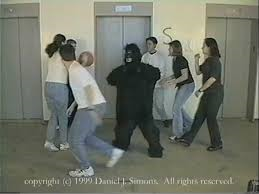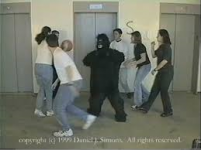What is it if it isn't engineering..... It involves analogue and digital engineering, acoustic engineering, mechanical engineering, measurements and listening are all part of this process!
Ok, but then it would be imho much better to stop joking (nearly) exclusively about people who listen and base their engineering decision on the results.
Of course you may have concerns about their methodology but having concerns isn´t the same as to _know_ they are wrong.
Please remember that 30 - 50% of the participants do _not_ detect the "gorilla" ...
Attachments
What has the gorilla got to do with the people who troll around on these forums claiming all sorts of mythical effects that don't exist outside of their minds, thus taking the discussion away from the things that actually DO matter?
I find the connotations of you now referring to your self as a master designer rather disquieting
Mr. Marce,
I hope you don't mind of me regarding Mr. Curl as a master audio designer.
(in the Germanic world, Master has a different meaning, in comparison to the gnome & hobbit galaxy)
I've had folks insist a 1W resistor has lower Johnson noise
I always assumed big'uns make more noise.
What has the gorilla got to do with the people who troll around on these forums claiming all sorts of mythical effects that don't exist outside of their minds, thus taking the discussion away from the things that actually DO matter?
If you don´t claim supernatural powers, you can´t know if something exists outside of their minds (perceptionwise don´t get me wrong).
I think we can agree on the fact, that people who don´t suffer from serious damage of their vision are able to see the "gorilla" , nevertheless it is quite easy to distract participants.
If it is quite easy even with large differences it is most likely much easier with smaller differences.
That´s the reason why the ITU-R BS.1116-x so vigorously recommends to check again every detail of a test setup before accepting to not reject the null hypothesis.
(A lot of tests wrt to various bias effects in controlled listening tests were done within the SDT , which is referenced in the AES-recommendation, that arnyk linked to before)
I always assumed big'uns make more noise.
When dropped, I hear they even fall faster.
I happen to have quite a truculent example for you, but totally unfit to post at a G-rated forum.
If you don´t claim supernatural powers, you can´t know if something exists outside of their minds (perceptionwise don´t get me wrong).
I think we can agree on the fact, that people who don´t suffer from serious damage of their vision are able to see the "gorilla" , nevertheless it is quite easy to distract participants.
If it is quite easy even with large differences it is most likely much easier with smaller differences.
Yes, which is why the likes of audioquest et al at hifi shows tell you what you hear when they change to their new wonder USB cable at only $$$$.
I'm still a little confused on your posts this morning, but will mull more and see if I can't work it out.
Ok, but then it would be imho much better to stop joking (nearly) exclusively about people who listen and base their engineering decision on the results.
Of course you may have concerns about their methodology but having concerns isn´t the same as to _know_ they are wrong.
Please remember that 30 - 50% of the participants do _not_ detect the "gorilla" ...
WHAT gorilla? 😱

I only see humans in that picture 😉
By the way, one of them is wearing a very poorly made gorilla costume. 🙄
Or he sucked too hard at the dispenser tube and was rewarded with a huge load of hair tonic:

Not forgetting also that it's unlikely that he weighs 500 pounds as the proverbial gorilla would.

Now if such fake examples are acceptable to some, I don't even want to imagine what credit will they give to unsubstantiated "sound reports" which to me read like written by a :

I've had folks insist a 1W resistor has lower Johnson noise.
It does. Shall I give you the Ed explanation why?
@ billshurv,
may i suggest reading the ITU-R BS.1116 ? It is available for download free of charge and covers a lot of the various difficulties in setting up a good listening test (but is not comprehensive)
@ JMFahey,
i used the quotation marks to guard against all Matisse like jokes..... 🙂
may i suggest reading the ITU-R BS.1116 ? It is available for download free of charge and covers a lot of the various difficulties in setting up a good listening test (but is not comprehensive)
@ JMFahey,
i used the quotation marks to guard against all Matisse like jokes..... 🙂
Ok, but then it would be imho much better to stop joking (nearly) exclusively about people who listen and base their engineering decision on the results.
Of course you may have concerns about their methodology but having concerns isn´t the same as to _know_ they are wrong.
Please remember that 30 - 50% of the participants do _not_ detect the "gorilla" ...
Please cite the source of this "fact".
Due to the many biases in the typical casual audiophile sighted evaluation, the only people who just listen are the ones doing DBTs.
Last edited:
If you don´t claim supernatural powers, you can´t know if something exists outside of their minds (perceptionwise don´t get me wrong).
Do a proper DBT. If its just in the mind, it will be a random effect and that comes out in the statistical analysis.
This looks like evidence that you cited BS 1116-2 without actually understanding it.
BS1116-2 seems to require a pile of registration hoops to jump through 🙁
BS1116-2 or -3 are designed to specify a listening test that is not only a valid DBT, but also one that will reliably plumb the depths of the sensitivity of the human ear.
IOW, it specifies a number of things that you don't have to worry about if less than utter sensitivity will satisfy your purposes.
In particular, audiophiles are constantly talking about differences that are so obvious that you'd have to be deaf to miss them.
If these differences are so obvious, why do they disappear even when you jump though all of the hoops in BS 1116-2?
Contrast all of the conditions that BS 1116-2 specifies in the interest of maximum sensitivity, with a typical audiophile audition of some audio gear.
There's no comparison - the audiophile test typically wouldn't find diddly-squat except for all the false positives due to the lack of proper control of even obvious irrelevant influences like level matching.
Last edited:
It does. Shall I give you the Ed explanation why?
SY,
Scott is talking about the thermal noise now named after John B. Johnson who worked with Harry Nyquist at Bell Labs.
Not your cousin Homer Johnson or whatever nonsense you want to imply.
Care to discuss the important result of applying the Johnson noise formula to electrical loads?
A larger resistor under use will ALWAYS have lower thermal noise than a smaller one. It will just heat up (perhaps a very tiny bit) less.
The difference may be infinitesimally small, and is most certainly insignificant, but at least there is a logical explanation why the effect should be there. However, to subsequently apply that to audio is either good marketing, bad thinking, or both.
The difference may be infinitesimally small, and is most certainly insignificant, but at least there is a logical explanation why the effect should be there. However, to subsequently apply that to audio is either good marketing, bad thinking, or both.
Scott is talking about the thermal noise now named after John B. Johnson who worked with Harry Nyquist at Bell Labs.
I don't have any Homers in my family. So care to say *why* a 1W resistor might have lower Johnson noise than a 1/2 watt or 1/4 watt resistor? Or have I out-Ed-ed Ed?
- Status
- Not open for further replies.
- Home
- Member Areas
- The Lounge
- Resistor Sound Quality?
